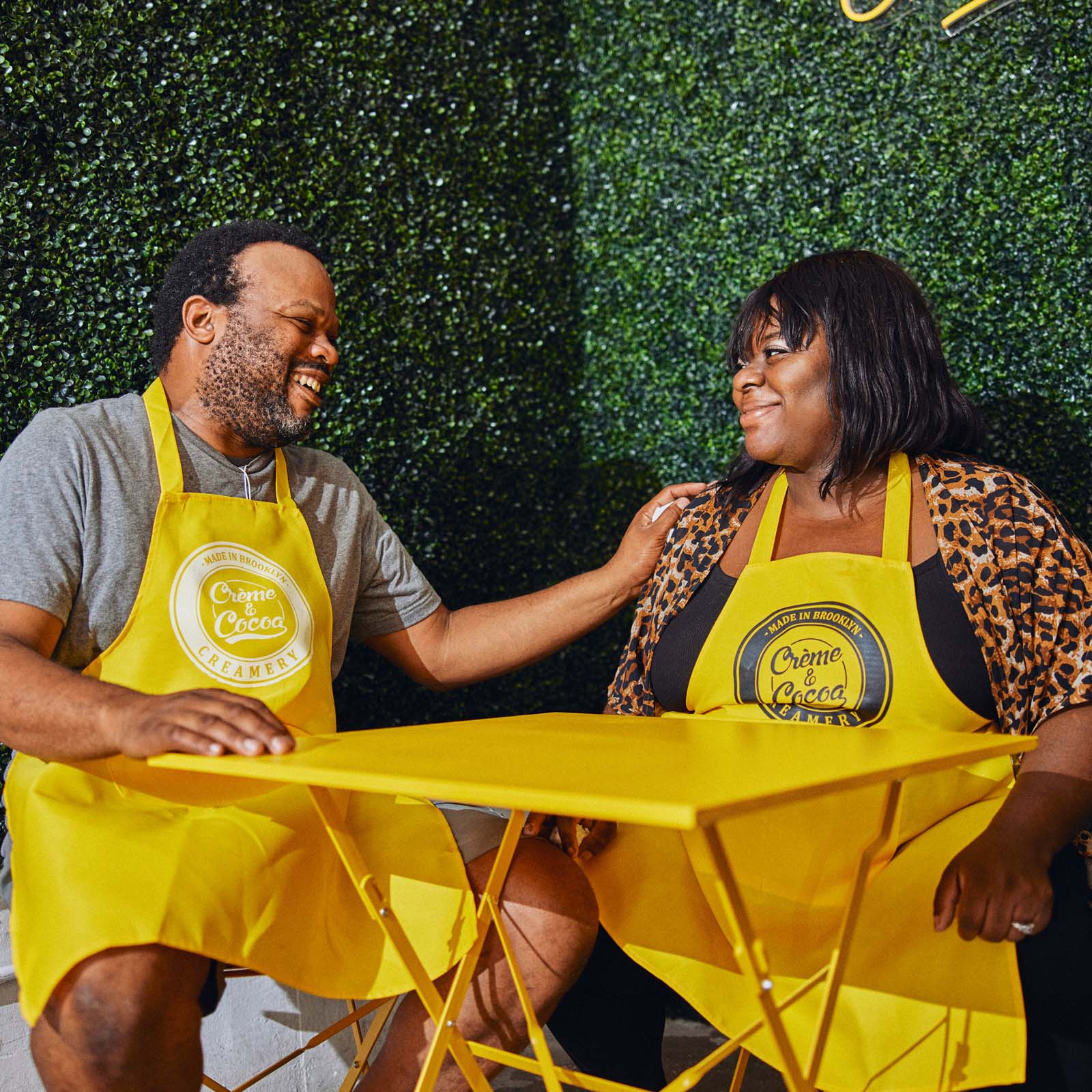
‘We love the fashion world just as much as our audience does,’ says Lawrence Schlossman, who's 35 and co-hosts weekly menswear podcast Throwing Fits. ‘At the same time, we can call bullshit on whatever we like. We can lean into the opinionated tone we might have had to suppress in the past, because of whoever was paying the bills, which you see quite often in the media space.’
Since it launched in 2020, Throwing Fits has been downloaded nearly 7 million times. Its tagline – ‘Two grown dirtbags just tryna navigate the male zeitgeist’ – sets out the podcast's always bro-y and affable tone. The discussions, while never less than compelling, frequently verge on hyperbole.
Menswear anchors the show, but the subject matter varies wildly. One recent podcast description, for example: ‘This week, Jimmy and Larry are getting together to sling some dubious claims on Afghan tailors, vile jeans, where Whiplash fits into the history of sigma male cinema, the latest Throwing Fits Beef Report™, Twitter's For You tab, real Larry moments […] hang out books, having sex before vs after dinner, making the pilgrimage to Jersey City for Lil Yachty's listening party…’

To a large extent, Lawrence had been working towards what Throwing Fits would become for many years. He had already started his own fashion blog, Four Pins, which he used to regularly lampoon the fashion industry, before he met James Harris, 35, the podcast's other co-host. Both were working at COMPLEX, a US media company specializing in youth culture, when they decided to launch their first podcast in the late 2010s.
‘Back in the day, James and I received quite a few slaps on the wrist,’ says Lawrence. ‘At a certain point, you want to be a commentator on your own terms. You don't want to have to run through levels of red tape to just express some watered-down version of an opinion about something that you truly care about.’
Throwing Fits has 3,900 monthly subscribers on Patreon, bringing in more than $20,000 a month. It's an important platform, says James, because ‘it gives us a foundational, baseline amount of revenue and that enables us to experiment and play in other spaces.’
Other spaces include merch and collaborations with brands like menswear site MR PORTER. ‘But, when you partner with us, you're not going to blow up overnight,’ says James. ‘It's not like Justin Bieber is wearing your shit. But hopefully the brands see a nice uptick in awareness, exposure and sales, and can grow at a pace that they want.’

Brand partnerships also allow Throwing Fits to create media that the pair are actually passionate about – rather than, say, chasing revenue by playing ball with the likes of whatever algorithms are being pushed by the tech giants. Plus, since the majority of these traditional outlets rely on advertising dollars for their survival, the lines of objectivity begin to blur. Membership support allows for a certain degree of objectivity and ‘I don't give a fuck’-ness, which has endeared Throwing Fits to audiences.
The men's fashion world wasn't always this way. Far from it. Fashion, especially men's fashion, has nearly always been beholden to a few consolidated power brokers. There was GQ, Esquire and their glossy magazine contemporaries, as well as columnists at big newspapers. The content was often narrow in scope and, when you looked closely, pretty similar. If you were interested in menswear, you had to conform to the vision of what publishers saw as important to discuss.
When message boards and blogging came about, things started to change. And, when social media happened, things really transformed. After all, style and fashion ideas could be uploaded at any time, from anywhere, with only a smartphone. Personal brand and online clout became things that everyone was aware of as influencers showed off their shopping hauls and NBA players started treating pre-game tunnel walks like a runway. With a few clicks, just about anyone could find the kind of style content they wanted – and creators could more readily find an audience for that content.
‘All media was just clicks, clicks, clicks, shares, virality,’ says James. ‘That's the media environment we were in previously, but we got lucky that we pulled the ripcord before we got too caught up.’ Lawrence agrees, adding: ‘We were forged in the fires of the listicle apocalypse.’
Now they create whatever content they want, in whatever form, from memes on Instagram to long-form interviews, discussing everything from underrated brands to a guest's sex life. ‘If anything, we work for the audience now, as opposed to advertisers or corporations,’ says Lawrence.

The new world of menswear
This irreverent take on modern-day style has struck a chord with people, who, just like the hosts, are in search of new formats discussing the style they love. Another popular outlet is Blackbird Spyplane, a Substack newsletter run by journalists Jonah Weiner and Erin Wylie, which boasts ‘unbeatable recon’ in the arena of culture and style via trend pieces and recommendations of small, under-the-radar brands. It has thousands of paying subscribers and has bagged interviews with heavyweights such as musicians André 3000, Lorde and Tyler, The Creator, footballer Héctor Bellerín and comedian Jerry Seinfeld.
Much like Throwing Fits, Blackbird Spyplane expresses itself via hyperbolic sentiments and, to some degree, insider knowledge. It serves to democratize men's style in some ways (less stuffy, less commercial, more of a members' club feel) but falls back into the same trends in other ways (insidery, with a sense of IYKYK).
Michael Williams launched A Continuous Lean in 2007. In those early days, it was one of a handful of ‘alternative’ menswear outlets. ‘But now the media landscape is much more complex and the traditional gatekeepers aren't as important as they once were,’ he says. ‘So all of these different voices are speaking to highly specific audiences, and all of these different influences mean there [are] almost no prevailing mono-trends in menswear any more – instead, there are 40 trends running concurrently – with a variety of creators and voices driving the culture. It's a pretty exciting time to be into fashion.’


Model and presenter Danny Lomas and creative director Jordan Rason started the podcast Dansplaining in 2022. Friends since they used to work together on PAQ, a wildly popular men's fashion YouTube show from youth media brand Kyra, the duo realized they were interested in speaking about various subcultures as they related to fashion. But they wanted to experiment with longer formats than typical social media posts allowed.
They launched Dansplaining to chat about life through the lens of fashion in a much less formal way. Their guests have included Tom Chamberlin, editor-in-chief of fashion magazine The Rake, artist Corbin Shaw and Tora Northman, head of TikTok at media brand Highsnobiety.
Jordan says, ‘So much of the fashion media out there was a bit too dry. I like the fun in fashion. That's what Danny's so good at. We thought we could get some mics and we could sit and chat to people. That's what we do at the pub anyway. It's not an act or a show.’
Danny adds, ‘It's nice to find out everyone's perks and quirks, and you only get that from longer-form interviews. Our mind wandering is what makes it relatable as well.’
‘We had the guys from Throwing Fits on,’ Jordan picks up. ‘We're talking about clothes the whole time, but then we end up talking about wrestling for 10 minutes. That's all in there, because that's where our minds wandered.’
This idea of less edited, more real ideas and opinions about fashion is attractive to so many people because of just how edited our lives seem to have become on social media. Danny and Jordan see it as a way to humanize people and their interests. ‘You want it to be serious, but still silly and fun, to keep guests on their toes and to provide some information that listeners can't just find with a quick Google,’ says Danny.
This younger-leaning, more representative group of people getting into the new world of men's fashion is not only fostering more creativity, it's also creating more opportunities. Danny, who's in his mid-20s, says that he wants to produce the kind of show that he'd have wanted to listen to when he was growing up in Yorkshire, in northern England, far away from the London-centric world of fashion.
‘I want to hear something niche from the guests so that listeners can be like: “Oh, no way, I like that too, but I thought if you liked that you wouldn't be into fashion.” I was that kid on the internet at 13, 14, 15, looking at these people with admiration and dreaming of working in fashion, living in London,’ he says. ‘I think we're in such a fortunate position because, if I was still a kid in Yorkshire, any of these guests I'd have killed to have on my podcast. So, I like to think about it as what would I want to hear from them as that 15-year-old-kid?’
Jordan adds: ‘Neither of us [have benefited] from any nepotism. We didn't have any “ins” in the industry. What a lot of people like is that they're getting this idea of how people get into the industry and what inspires them… It's not just about #menswear or really high fashion. It doesn't matter whether you're into avant-garde fashion or streetwear, and that, for us, is what makes it interesting, where we start to get other people's viewpoints on why they're interested in fashion.’
There are also more platforms than ever before to get your voice out there. ‘Some people only know us as an Instagram, and that's fine,’ says James from Throwing Fits. ‘Some people only know us as a podcast, they don't fuck with the memes, and that's fine, too… We have this whole world and community and we're not necessarily thinking about how we can convert these 100,000 Instagram followers into podcast listeners. You don't need to be the most listened to podcast to be the most effective podcast. Let the podcast be the podcast, and make similar waves across other platforms.’

A version of this article was first published in Courier issue 50. To purchase the issue or become a subscriber, head to our webshop.



